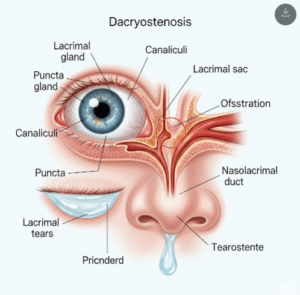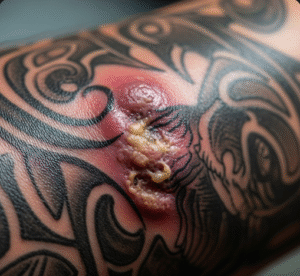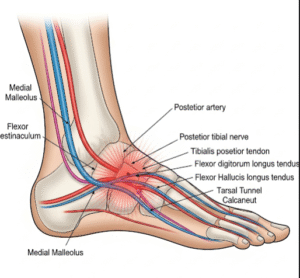Overview
Ocular syphilis is a form of syphilis infection that affects the eyes, potentially leading to serious visual impairment or blindness if left untreated. Caused by the bacterium Treponema pallidum, ocular syphilis can occur at any stage of syphilis infection, including primary, secondary, or latent stages. It is considered a medical emergency and requires prompt diagnosis and antibiotic treatment.
Though rare, cases of ocular syphilis have increased in recent years, especially among individuals with HIV infection or other immunocompromised conditions.
What is Ocular Syphilis?
Ocular syphilis refers to inflammation and infection of one or more parts of the eye due to systemic syphilis. It can affect the uvea (uveitis), retina (retinitis), optic nerve (optic neuritis), cornea, or conjunctiva. It may involve one or both eyes and can present with a range of symptoms, often resembling other eye diseases.
Ocular syphilis is part of neurosyphilis, as the optic nerve and eye structures are considered part of the central nervous system. Because of its wide range of manifestations, it is often referred to as “the great imitator.”
Symptoms
Symptoms can vary widely depending on which part of the eye is affected. Common signs and symptoms include:
- Blurred vision or sudden vision loss
- Eye pain or discomfort
- Redness in one or both eyes
- Photophobia (sensitivity to light)
- Floaters or flashes
- Double vision
- Tearing or discharge
- Swollen eyelids or conjunctiva
- In severe cases, complete blindness
Symptoms can develop gradually or suddenly, and visual impairment can be reversible with early treatment.
Causes
Ocular syphilis is caused by the Treponema pallidum bacterium, which is spread through:
- Sexual contact (oral, vaginal, anal)
- Congenital transmission (from mother to fetus)
- Direct contact with syphilitic sores
After entering the bloodstream, the bacteria can spread to the eyes and central nervous system. Ocular involvement may occur months or years after the initial infection if syphilis is not adequately treated.
Risk Factors
People at higher risk for ocular syphilis include:
- Individuals with untreated or inadequately treated syphilis
- Men who have sex with men (MSM)
- HIV-positive individuals
- People with multiple sexual partners or unprotected sex
- Previous history of syphilis or other STIs
- Substance abuse
- Immunocompromised states
Co-infection with HIV may result in more severe ocular symptoms and a higher risk of recurrence.
Complications
If left untreated, ocular syphilis can lead to:
- Permanent vision loss or blindness
- Optic nerve atrophy
- Retinal detachment or scarring
- Glaucoma or cataracts
- Recurrent uveitis
- Disseminated neurosyphilis
- Increased HIV transmission and progression (if co-infected)
Prompt treatment dramatically reduces the risk of long-term eye damage.
Prevention
Preventing ocular syphilis involves both sexual health awareness and early treatment of systemic syphilis:
- Use condoms during all forms of sexual activity
- Get regular STI screenings, especially if sexually active with multiple partners
- Notify and treat partners of anyone diagnosed with syphilis
- Adhere to complete antibiotic therapy if diagnosed with syphilis
- Screen for syphilis in individuals with unexplained uveitis or visual symptoms
- People living with HIV should have routine syphilis testing
Avoiding high-risk behaviors and maintaining regular checkups can prevent serious complications.
Treatment Options in Korea
South Korea offers advanced diagnosis and treatment of ocular syphilis through collaborative care between ophthalmology, infectious disease specialists, and neurologists.
1. Diagnosis
- Eye examination (slit-lamp, funduscopy)
- Visual acuity and field testing
- Optical Coherence Tomography (OCT) and fluorescein angiography for retinal involvement
- Blood tests:
- Non-treponemal tests: RPR or VDRL
- Treponemal tests: FTA-ABS or TP-PA
- Lumbar puncture (spinal tap) to check for neurosyphilis
- HIV testing (strongly recommended)
- Brain imaging (MRI/CT) if neurological symptoms present
2. Medical Treatment
- High-dose intravenous penicillin G for 10–14 days (standard treatment)
- For penicillin-allergic patients: desensitization or ceftriaxone as an alternative
- Oral doxycycline (in limited cases or mild presentations)
- Corticosteroids may be used cautiously to reduce inflammation
- Antiretroviral therapy (ART) for HIV-positive patients
3. Monitoring and Follow-Up
- Frequent eye exams during and after treatment
- Repeat serologic tests to confirm response
- Monitor for recurrence or progression
- Treat all sexual partners to prevent reinfection
4. Top Hospitals in Korea for Ocular Syphilis Care
- Seoul National University Hospital – Infectious Disease & Eye Clinic
- Asan Medical Center – Neurology, Infectious Disease, and Ophthalmology Departments
- Samsung Medical Center – Retina and Uveitis Specialty Unit
- Severance Hospital (Yonsei University) – Uveitis & Neuro-Ophthalmology Center
- Korea University Guro Hospital – STI and Vision Loss Treatment Clinic
These facilities offer:
- Multidisciplinary care with infectious disease, neurology, and eye specialists
- Emergency treatment for ocular and neurosyphilis
- Advanced diagnostic imaging and lab support
- Multilingual services for international patients













